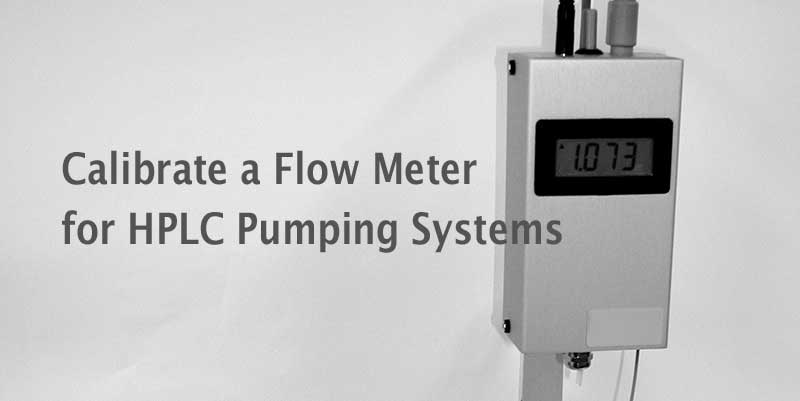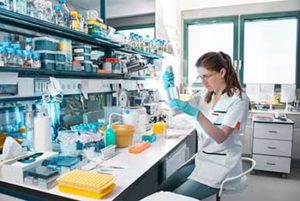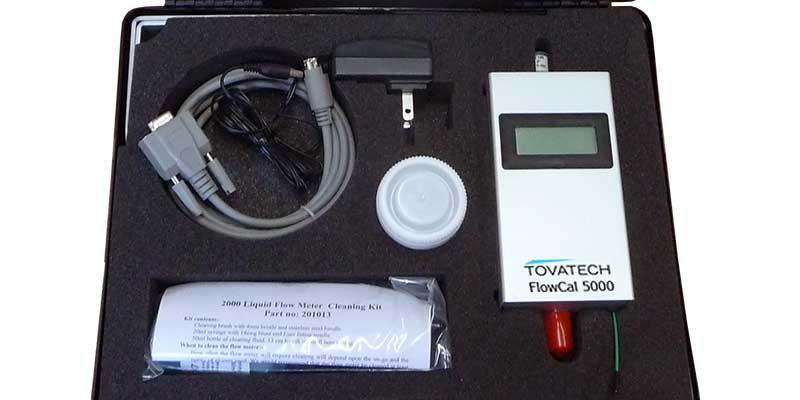
Flow Meter Calibration for HPLC Pumping Systems
Calibrating digital liquid flow meters that test high performance liquid chromatography (HPLC) pumping systems is performed prior to units being put into service. In accordance with GLP and to comply with other regulations, flow meter calibration – recalibration – should be performed annually. Digital HPLC flow meter recalibration is an exacting procedure requiring experts using high-precision measuring instruments. We describe it in this post after a brief explanation on
What Flow Meters Meter
As the name implies, flow meters measure the rate of flow of a product, usually through a pipeline or processing line. Gasoline pump flow meters at your local filling station are another common example. Standards may apply to periodic certification by calibrating flow meters to confirm that you are getting the fuel you pay for. Heating oil, natural or propane gas are also delivered via flow meters that vendors use to calculate your bill.
As another example, industrial applications may employ flow meters to measure flow rates in thousands of gallons per minute.
Why Flow Meter Calibration for HPLC Pumping Systems is Different
The answer in a few words: Instead of measuring flow rates in gallons per minute, flow meters for HPLC pump systems measure rates in fractions of milliliters per minute.
As described in our post on how a digital flow meter works they are used to measure the accuracy of HPLC pumping systems in order to meet FDA and other regulations regarding installation qualification (IQ), operational qualification (OQ) and performance qualification (PQ) of equipment used in the pharmaceutical and biopharmaceutical industries as well as other analytical labs.
The process demands accurate, reproducible column retention time as an analyte (what is being analyzed) is pumped through the HPLC system.
Consistent and accurate performance is an absolute necessity. But complicating things is that HPLC pumping systems are composed of parts subject to leaks and wear when particulates settle in their components.

And unlike the local gas pump or your fuel oil delivery truck, HPLC pumping systems must accommodate flow rate accuracy such as 0.05 to 25 milliliters per minute. This demands care to avoid or at least minimize wear on HPLC pump system parts.
But equipment wear does occur, and accuracy impacted meaning HPLC pump system testing is required. Testing is accomplished using flow meters that must, in turn, be calibrated on a periodic basis.
To get back to the subject of our post:
Flow Meter Calibration for HPLC Pumping Systems
First a description of a widely used calibrating tool for HPLC pumping systems. It is the Tovatech FlowCal 5000 HPLC digital liquid flowmeter.
These lightweight and extremely portable flow meters are shipped factory calibrated along with an accompanying calibration certificate for a flow rate of 1.0 ml/min plus additional flow rates requested by the customer. The calibration certificate certifies that the displayed flow rate is within ±1% of the actual flow rate at each calibration point.
Initial Flow Meter Certification
Calibration points recorded on the certificate are not based on single measurements. Instead, they result from an extensive process aimed at achieving statistically accurate data by taking, for example, 30+ readings at 0.5ml/min, 40+ readings at 1.0ml/min and ~100 readings at 5.0ml/min.
Data are captured and averaged via an RS 232 interface to a PC. The certificate shows the average of these readings at each flow rate. The percent error and percent standard deviation from the actual flow rates are also calculated from these averages and shown on the certificate.
The actual flow rate is determined gravimetrically, not with a reference flowmeter, but by collecting a mass of water passing through the flow meter over a recorded period of time.
The mass of water is converted to a volume of water by correcting for density (based on the water temperature). The actual flow rate can then be ascertained from the volume over time measurements.
This is compared to the displayed readings on the flowmeter. The firmware of the flow meter is adjusted to allow the displayed rate to match the actual flow.
Calibration equipment, the balance and counter timer are calibrated annually by an accredited certification lab. This provides traceability of measurement to recognized national standards.
HPLC Flow Meter Recalibration Processes
As we said in our opening paragraph, this calls for experts using high-precision measuring instruments.
In accordance with GLP and to comply with other regulations, digital liquid flowmeters should be recalibrated annually. Recalibration procedures follow the same format used for initial flow meter calibration as described above.
The flow meter is first flushed with water. Then “as found” (or “before”) readings are taken at 1.0ml/min to measure the accuracy of the flow meter in the state in which it was received.
Customers may request that the new flow meter calibration certificates show “before” data at all the calibration points rather than exclusively at 1.0 ml/min.
The flow tube is cleaned, sensors are checked, any repairs undertaken, and necessary adjustments are made to bring the flow meter into specification.
The flow meter is then calibrated to all the customer’s required flow rates. “After” data are recorded on the calibration certificate to confirm that the returned unit is performing according to specification.

Suggested Flow Meter Maintenance Tips
While GLP requires yearly flow meter recalibration, proper use and maintenance help avoid degradation of your unit that can render it inaccurate.
This, of course, will compromise fast, accurate calibration of HPLC pumping system flow rates.
Maintenance instructions are included in user manuals and cleaning kits shipped with the flowmeters. Here are some tips:
- Every two weeks clean meters in constant use in a process that should take about 15 minutes.
- Do not introduce two immiscible liquids into the flowmeter without either allowing the first to fully evaporate or by introducing a third solvent in which the others are miscible.
- A dirty sensing tube may trap bubbles and create falsely high readings. If bubbles are observed, a quick fix is to turn the unit off, wait approximately two seconds to allow it to drain, then switch it on. Regular use of the cleaning kit will avoid this problem. Do not disassemble the unit.
- To help prevent algae growth in the tube flush the flowmeter with ethanol if it will not be used for a week or more.
These digital liquid flow meters have been performance-proven in the field as a way to save time and improve accuracy when checking HPLC system pump rates. Check the testimonials at the bottom of our FlowCal 5000 Digital Liquid Flow Meter page to see how others use these precision instruments to save time while improving vital accuracy.
Contact Tovatech’s scientists for answers to other questions you may have regarding the FlowCal 5000 digital liquid flowmeter.

